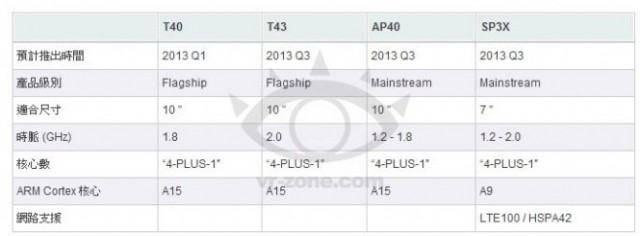
The Tegra 4 SoC is expected to provide improved graphics performance of up to 5x from Tegra 3, which itself has yet to be widely distributed among mainstream phones and tablets. We’ve seen benchmarks of the Tegra 3-powered Asus Transformer Prime, and while it is a vast improvement graphically over equivalent dual-core Qualcomm and PowerVR GPUs, its CPU architecture is identical to the Cortex-A9 chips we’ve been seeing in devices for two years.
Nvidia’s Tegra 4 chipset is expected to bump up performance and thermal dissipation by changing to a 28nm manufacturing process and ARM’s Cortex-A15 design, which provides 30% better benchmarks from the same speed. If a leaked roadmap of the company’s plans are to be believed, we should see the first flagship SoCs in devices by early next year, with larger tablets getting first dips. The quad-core T40 chip will run at 1.8Ghz, while the subsequent T43 should peak at 2Ghz. More mainstream models, the AP40, clocked between 1.2-1.8Ghz per core, will debut later in the year for lower-priced devices.
What’s interesting is a Cortex-A9 chip clocked between 1.2 and 2Ghz, dubbed SP3X, should pick up the LTE/DC-HSPA+ slack when it debuts in Q3 2013, which seems a long way off. The Tegra 3 design was not LTE-ready upon its release but is expected to have the baseband capabilities by the end of 2012; the SP3X could merely be the only phone-specific LTE-capable SoC in the timeline, while the rest will rely on third-party chips from other manufacturers (or Nvidia’s recent acquisition, Icera) to provide the capabilities.
With a new Tegra SoC expected every year, the Tegra 4 should keep Nvidia in good stead for battling Qualcomm, Texas Instruments, Samsung and a variety of other ARM-based chips hitting the market this year.
Source: Engadget
MobileSyrup may earn a commission from purchases made via our links, which helps fund the journalism we provide free on our website. These links do not influence our editorial content. Support us here.


